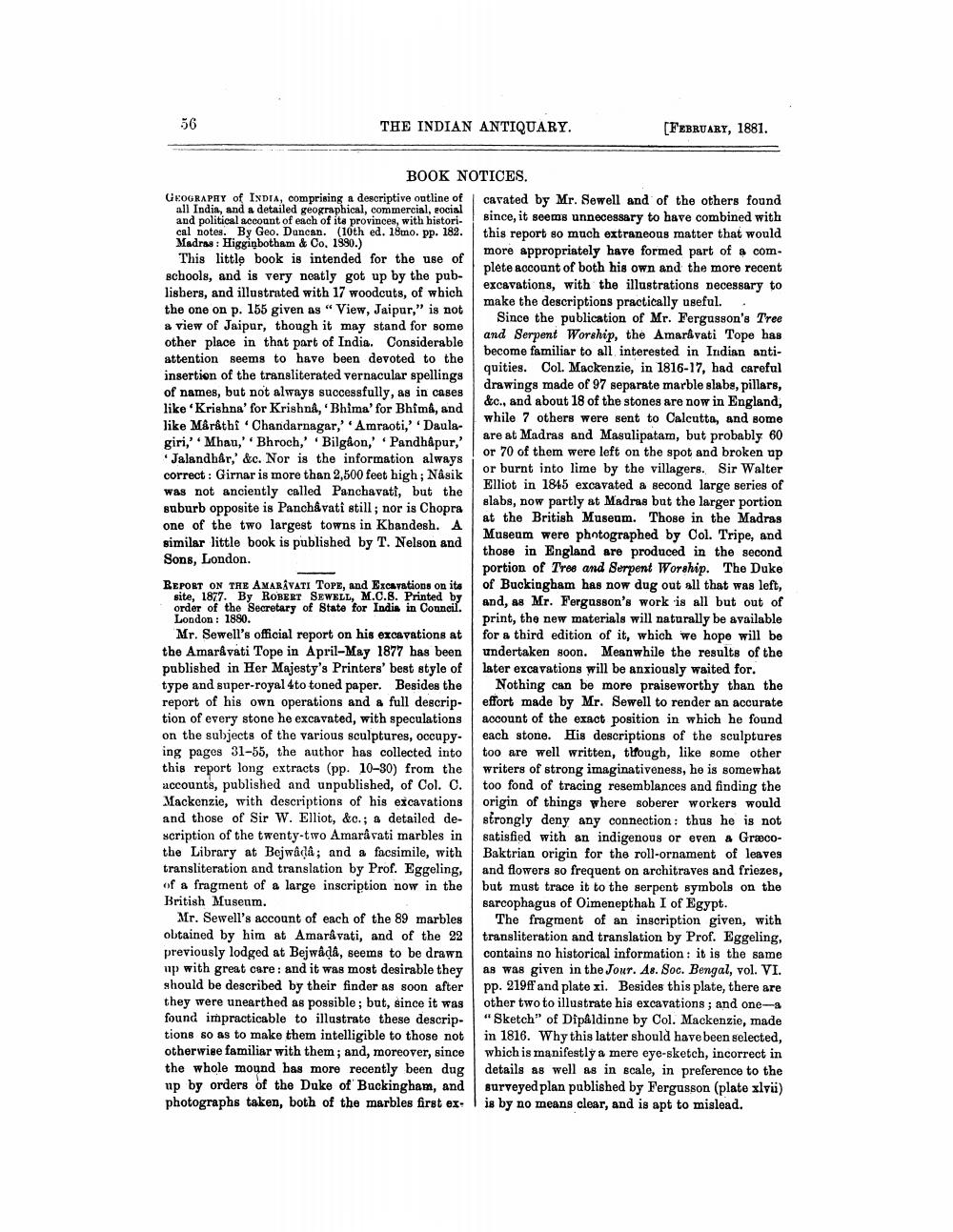________________
56
THE INDIAN ANTIQUARY.
BOOK NOTICES.
GEOGRAPHY of INDIA, comprising a descriptive outline of all India, and a detailed geographical, commercial, social and political account of each of its provinces, with historical notes. By Geo. Duncan. (10th ed. 18mo. pp. 182. Madras: Higginbotham & Co. 1830.)
This little book is intended for the use of
schools, and is very neatly got up by the publishers, and illustrated with 17 woodcuts, of which the one on p. 155 given as " View, Jaipur," is not a view of Jaipur, though it may stand for some other place in that part of India. Considerable attention seems to have been devoted to the
insertion of the transliterated vernacular spellings of names, but not always successfully, as in cases like 'Krishna' for Krishna, 'Bhima' for Bhîmâ, and like Mârâthi Chandarnagar,' ' Amraoti,' 'Daulagiri,' Mhau,'' Bhroch,' 'Bilgâon,' 'Pandhapur,' Jalandhar,' &c. Nor is the information always correct: Girnar is more than 2,500 feet high; Nâsik was not anciently called Panchavati, but the suburb opposite is Panchâvati still; nor is Chopra one of the two largest towns in Khandesh. A similar little book is published by T. Nelson and Sons, London.
REPORT ON THE AMARAVATI TOPE, and Excavations on its site, 1877. By ROBERT SEWELL, M.C.S. Printed by order of the Secretary of State for India in Council. London: 1880.
Mr. Sewell's official report on his excavations at the Amaravati Tope in April-May 1877 has been published in Her Majesty's Printers' best style of type and super-royal 4to toned paper. Besides the report of his own operations and a full description of every stone he excavated, with speculations on the subjects of the various sculptures, occupying pages 31-55, the author has collected into this report long extracts (pp. 10-30) from the accounts, published and unpublished, of Col. C. Mackenzie, with descriptions of his excavations and those of Sir W. Elliot, &c.; a detailed description of the twenty-two Amaravati marbles in the Library at Bejwâdâ; and a facsimile, with transliteration and translation by Prof. Eggeling, of a fragment of a large inscription now in the British Museum.
Mr. Sewell's account of each of the 89 marbles obtained by him at Amaravati, and of the 22 previously lodged at Bejwâdâ, seems to be drawn up with great care: and it was most desirable they should be described by their finder as soon after they were unearthed as possible; but, since it was found impracticable to illustrate these descriptions so as to make them intelligible to those not otherwise familiar with them; and, moreover, since the whole mound has more recently been dug up by orders of the Duke of Buckingham, and photographs taken, both of the marbles first ex
[FEBRUARY, 1881.
cavated by Mr. Sewell and of the others found since, it seems unnecessary to have combined with this report so much extraneous matter that would more appropriately have formed part of a complete account of both his own and the more recent excavations, with the illustrations necessary to make the descriptions practically useful.
Since the publication of Mr. Fergusson's Tree and Serpent Worship, the Amaravati Tope has become familiar to all interested in Indian anti
quities. Col. Mackenzie, in 1816-17, had careful drawings made of 97 separate marble slabs, pillars, &c., and about 18 of the stones are now in England, while 7 others were sent to Calcutta, and some are at Madras and Masulipatam, but probably 60 or 70 of them were left on the spot and broken up or burnt into lime by the villagers. Sir Walter Elliot in 1845 excavated a second large series of slabs, now partly at Madras but the larger portion at the British Museum. Those in the Madras Museum were photographed by Col. Tripe, and those in England are produced in the second portion of Tree and Serpent Worship. The Duke of Buckingham has now dug out all that was left, and, as Mr. Fergusson's work is all but out of print, the new materials will naturally be available for a third edition of it, which we hope will be undertaken soon. Meanwhile the results of the later excavations will be anxiously waited for.
Nothing can be more praiseworthy than the effort made by Mr. Sewell to render an accurate account of the exact position in which he found each stone. His descriptions of the sculptures too are well written, though, like some other writers of strong imaginativeness, he is somewhat too fond of tracing resemblances and finding the origin of things where soberer workers would strongly deny any connection: thus he is not satisfied with an indigenous or even a GræcoBaktrian origin for the roll-ornament of leaves and flowers so frequent on architraves and friezes, but must trace it to the serpent symbols on the sarcophagus of Oimenepthah I of Egypt.
The fragment of an inscription given, with transliteration and translation by Prof. Eggeling, contains no historical information: it is the same as was given in the Jour. As. Soc. Bengal, vol. VI. pp. 219ff and plate xi. Besides this plate, there are other two to illustrate his excavations; and one-a "Sketch" of Dipâldinne by Col. Mackenzie, made in 1816. Why this latter should have been selected, which is manifestly a mere eye-sketch, incorrect in details as well as in scale, in preference to the surveyed plan published by Fergusson (plate xlvii) is by no means clear, and is apt to mislead.




